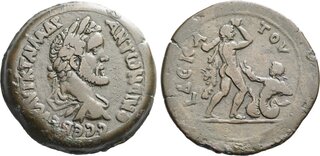| Numismatica Ars Classica > Auction 144 with CNG & NGSA | Auction date: 8 May 2024 |
| Lot number: 1081 Price realized: This lot is for sale in an upcoming auction - Bid on this lot  | Show similar lots on CoinArchives Find similar lots in upcoming auctions on |
| Lot description: The Geoffrey Cope Collection of Ancient Greek and Roman Bronzes. The Roman Empire. Antoninus Pius augustus, 138 –161. Description Drachm, Alexandria 146-147 (year 10), Æ 36 mm, 28.35 g. ΑΥΤ Κ Τ ΑΙΛ ΑΔΡ ΑΝΤωΝΕΙΝΟ? ?ΕΒ ΕΥ? Laureate head r. Rev. L ΔΕΚΑΤΟΥ Heracles and the Hydra: Heracles advancing r., lion skin around neck, raising club to strike Hydra on ground to r. Reference Dattari-Savio 8488 (this coin) Geissen 1537 RPC 989.4 and 6 (this coin, listed twice) Condition Very rare. Struck on a very large flan and with a lovely brown tone. Good very fine Provenance Karl Kress sale 154, 1972, 365 SAN sale 4, 4 (1972-1973), 63-5 NFA-Leu sale 16 May 1984, Garrett, 802 CNA sale 13, 1990, Wetterstrom, 192 From the Dattari collection. Note: For his Second Labour, Eurystheus required Heracles to slay the Hydra, a monstrous nine-headed water serpent that terrorised the region around the city of Lerna in Argolis. Together with his nephew, Iolus, Heracles tracked the monster to its lair in the marshes around the spring of Amymone. At first Heracles attempted to cut off its heads, but each time one was severed, two new heads grew up in its place. The problem was solved by Iolus, who quickly came up with a burning torch to cauterise the wound every time the hero cut off a head, thereby preventing the Hydra from growing new ones. Once the monster was slain, Hercules dipped his arrows in the deadly poison that the Hydra had for blood. It is generally believed that the scene depicted on the reverse of this coin reflects the struggle with the Hydra, although the monster has been unusually anthropomorphized and Heracles is somewhat unexpectedly shown striking it down with his club. The usual explanation for these peculiarities is that Echidna, the serpent-bodied mother of the Hydra is shown in place of her terrifying child. On the other hand, it also seems possible that the engraver may have intentionally conflated the Hydra episode, with Heracles' involvement in the Gigantomachy-an epic battle between the Olympian gods and the Giants, who were traditionally depicted with serpentine legs in Greek artistic tradition. In this battle, which was most famously depicted on the frieze of the Great Altar of Zeus at Pergamum, Heracles fulfilled an old oracle stating that the gods would only be victorious if they had the assistance of a mortal. Estimate: 2500 CHF |  |



